WORLD CLASS COACHING
Advanced Shooting and Finishing Volume 1
By Luca Bertolini
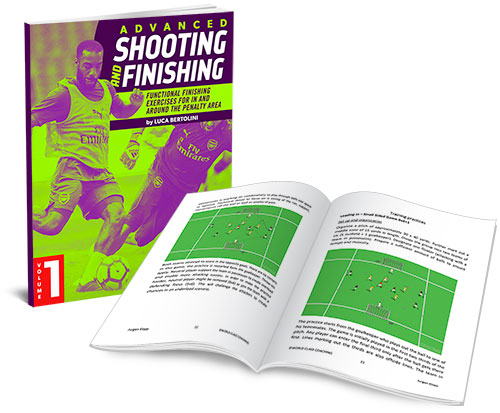
TABLE OF CONTENTS
Part One
INTRODUCTION
DRIBLLING AND/OR PASSING AREAS
SHOOTING AREAS
START FROM WIDE/DEEP AND SHOOT FROM WIDE/LONG
Part Two
START FROM WIDE/DEEP AND SHOOT FROM CENTER/LONG
Part Three
START FROM WIDE/DEEP AND SHOOT FROM INSIDE THE PENALTY AREA
Part Four
START FROM INSIDE THE PENALTY AREA AND SHOOT FROM THERE
Introduction
This e-book collection’s goal is to help coaches and then the players to recognize some game situations on the field while their team is in possession in the final third which could help them move to the finishing stage.
How many times does a team lose a scoring chance because of a wrong last pass, because of a wrong run without the ball, or because of the right pass but with wrong timing?
Moreover, how many times is a scoring chance missed because of the wrong tempo or because the move rhythm was not accelerated before shooting on goal?
This is the reason why I divide the final third of an attack into four passing areas and three shooting areas; they are combined together in each section of this e-book and all the related exercises are useful to create scoring chances and to shoot on goal as quickly as possible.
All the exercises are organized following the principle of the increasing difficulty level: from a simple basic level without opposition's pressure, to more complex game situations involving small group duels, passing through exercises with 1 v 1 or 2 v 2 duels under the pressure of time.
Often a correctly oriented ball control or a simple but well weighted pass can make the difference between a score and a miss. The difference can also be a 1 v 1 duel quickly solved or a small group’s duel quickly solved with the right pass at the right time.
The exercises of this e-book collection are designed while thinking about the areas where the last pass usually comes from or where the ball is usually dribbled through, and about the areas where the shots are usually kicked to finish; all the sequences and the small duels are suitable for shooting as many times as possible.
The final third is divided into 4 passing or dribbling areas:
• wide and deep spaces on the flanks
• wide spaces on the flank in the final third
• center spaces in the final third
• the penalty area
And the final third is divided in 3 shooting areas:
• outside corners of the penalty area
• the center spaces out of the penalty area
• inside the penalty area
All the sequences are the results of the dribbling, passing and shooting combination between those areas and among the players who are placed inside those areas. The goalkeeper always starts the exercises.
Dribbling and/or Passing areas
Dribble or pass from wide and deep spaces on the flanks: back passes are played toward the player or the players who must try to finish.

Dribble or pass from wide spaces along the flanks in the final third: from these areas, the last passes can be played toward the center spaces or inside the penalty area even through long balls.

Dribble or pass from center spaces in the final third: last passes are usually played inside the penalty area to finish as quickly as possible.

Dribble or pass from and in the penalty area: short and quick passes should be played inside or just outside with one touch passes to shoot on goal.

Shooting areas
Shoot from outside corners of the penalty area: usually after feints or dribbling the ball toward the goal.

Shoot from the center spaces out of the penalty area: usually the players must shoot with one touch or through fast pass combinations and feints.

Shoot inside the penalty area: usually with one touch as the ball arrives from outer spaces (behind or from outside).

Dribble or pass from wide and deep spaces on the flanks and shoot from outside corners of the penalty area


Exercise 1: 1 v the goalkeeper (1)

Sequence: The goalkeeper passes the ball outside the penalty area; the receiver must control the ball, dribble it, turn around the cone and shoot on goal. The same sequence can be carried out on the other side.
Variation: Fix a limit of time to shoot on goal.
Eye on: Dribble speed and quickness to shoot on goal after the change of direction around the cone.
Exercise 2: 1 v 1 (1)

Sequence: The goalkeeper passes the ball outside the penalty area; the receiver must control the ball, dribble it, turn around the cone, win the 1 v 1 duel against the defender and shoot on goal. The same sequence can be carried out on the other side.
Variation 1: The defender can decide to put pressure on the receiver before the first control or after the change of direction around the cone.
Variation 2: Fix a limit of time to shoot on goal; after that the defender can shoot on goal.
Eye on: Dribble speed, feints to win the 1 v 1 duel, quickness to shoot on goal after the change of direction around the cone.
Exercise 3: 1 v 1 (2)

Sequence: The goalkeeper passes the ball outside the penalty area; the receiver must control the ball, play a triangle combination with the defender, receive the back pass over the cone, win the 1 v 1 duel against the defender and shoot on goal. The same sequence can be carried out on the other side.
Variation: Fix a limit of time to shoot on goal; after that the defender can shoot on goal.
Eye on: Quick passing combinations, feints to win the 1 v 1 duel, quickness to shoot on goal after the change of direction around the cone.
Exercise 4: 1 v 1 (3)

Sequence: The goalkeeper passes the ball outside the penalty area; the receiver must control the ball, and pass back toward a teammate who then must control the ball on this side of the cones, saving the possession against the defender, win the 1 v 1 duel and shoot on goal. The defender must put pressure on the player in possession with the right time while he's receiving. The same sequence can be carried out on the other side.
Variation: Fix a limit of time to shoot on goal; after that the defender can shoot on goal.
Eye on: Quick passing combinations, feints to win the 1 v 1 duel, quickness to shoot on goal when the possession in ensured. Timing of the defensive pressure.
Exercise 5: 1 v 1 (3)

Sequence: The goalkeeper passes the ball outside the penalty area; the receiver must control the ball, and pass toward a teammate between the cones toward the direction of run of a teammate. The receiver then must control the ball cutting inside, saving the possession against the defender, win the 1 v 1 duel and shoot on goal. The defender must put pressure on the player in possession with the right time while he's receiving. The same sequence can be carried out on the other side.
Variation: Fix a limit of time to shoot on goal; after that the defender can shoot on goal.
Eye on: Quick passing combinations, feints to win the 1 v 1 duel, quickness to shoot on goal when the possession is ensured. Timing of the runs without the ball to receive and of the defending pressure to win it.
Exercise 6: 1 v 1 (4)

Sequence: The goalkeeper passes the ball outside the penalty area; the receiver must control the ball, and play a 1 - 2 combination with a teammate. He must receive the back pass in the space between the cones and on this side of the ideal defender line; this way he's not off-sides. The receiver then must control the ball cutting inside, saving the possession against the defender, win the 1 v 1 duel and shoot on goal. The defender must put pressure on the player in possession at the right time while he's receiving. The same sequence can be carried out on the other side.
Variation: Fix a limit of time to shoot on goal: after that the defender can shoot.
Eye on: Quick passing combinations, feints to win the 1 v 1 duel, quickness to shoot on goal when the possession in ensured, timing of the runs without the ball to receive and not to be off-side and of the defending pressure to win the ball.
Exercise 7: Shoot after receiving from a 1 v 1 duel (1)

Sequence: The goalkeeper passes the ball into the square space between the penalty area and the side line; a 1 v 1 duel is played inside there. The attacker must receive and control the ball against the pressure of a defender. A second attacker must be served outside this space and he must shoot on goal quickly. The defender must put pressure on the first player in possession with the right time while he's receiving. The same sequence can be carried out on the other side.
Variation 1: Fix a limit of time to win the 1 v 1 duel: after that the defender can finish 1 v 1 against the goalkeeper.
Eye on: Quick passing combinations, feints to win the 1 v 1 duel, quickness to shoot on goal as the ball is controlled.
Exercise 8: Shoot after receiving from a 1 v 1 duel (2)
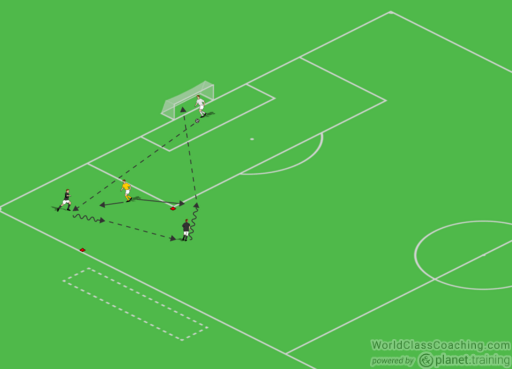
Variation 2: This is a second variation of the previous exercise. The defender can decide to defend 1 v 1 against the first receiver or against the attacker who must shoot. Or he can defend against them both.
Exercise 9: Shoot after a double 1 v 1 duel
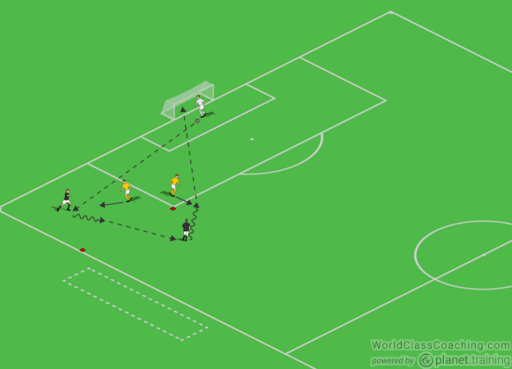
Sequence: The goalkeeper passes the ball into the square space between the penalty area and the side line; a 1 v 1 duel is played inside that area. The player who is able to keep the possession passes the ball out of the space, where a second 1 v 1 duel is carried out. Both the defenders must put pressure on the opponent in possession with the right time while he's receiving. Variation 1: Fix a limit of time to win the 1 v 1 duel: after that the defender wins the possession or the second one can finish.
20
Eye on: Feints to win the 1 v 1 duels, quickness to shoot on goal as the ball is received.
Exercise 10: The 3rd man shoots after a double 2 v 2 duel (1)

Sequence: The goalkeeper passes the ball into the square space between the penalty area and the side line; a 2 v 2 duel is played inside there. The red free player can be served only after a 1-2 or wall passing combination; he must score for the team in possession. Both the defenders can put pressure only on the black players.
Variation 1: Fix a limit of time to win the 2 v 2 duel: after that the defenders win the possession. Variation 2: One defender can play against the free player out the square.
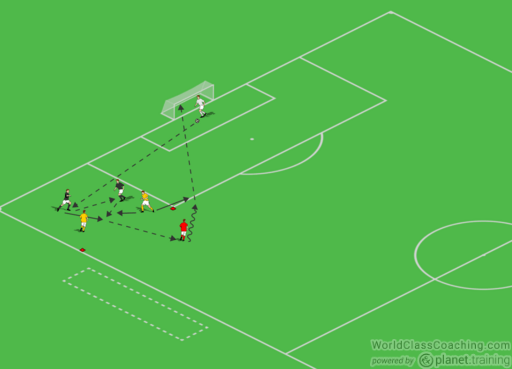
Eye on: Passing combinations to win the 2 v 2 duel, quickness to shoot on goal as the ball is received. Exercise 11: The 3rd man shoots after a double 2 v 2 duel (2)
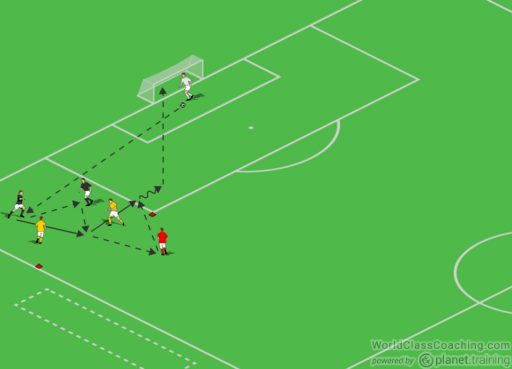
Sequence: The goalkeeper passes the ball into the square space between the penalty area and the side line; a 2 v 2 duel is played inside there. The red free player can be served only after a 1-2 or wall passing combination; the players in possession can score after a new wall passing combination with the red free player, paying attention to receive the ball when they are not off-side. Both the defenders can put pressure only on the black players inside or outside the square.
Variation 1: Fix a limit of time to win the 2 v 2 duel: after that the defenders win the possession.
Variation 2: One defender can play against the free player out the square.
Eye on: Passing combinations to win the 2 v 2 duel, quickness to shoot on goal as the ball is received.


